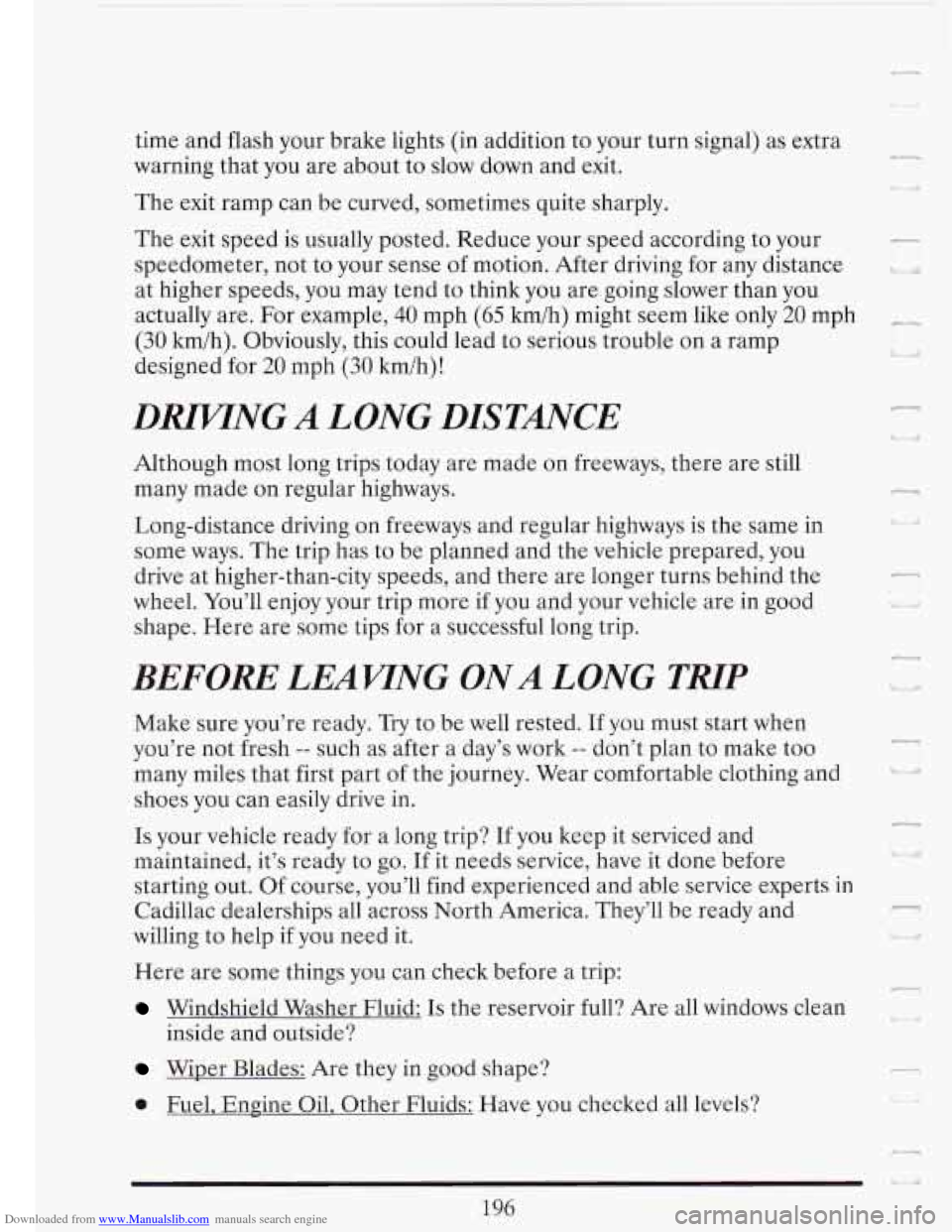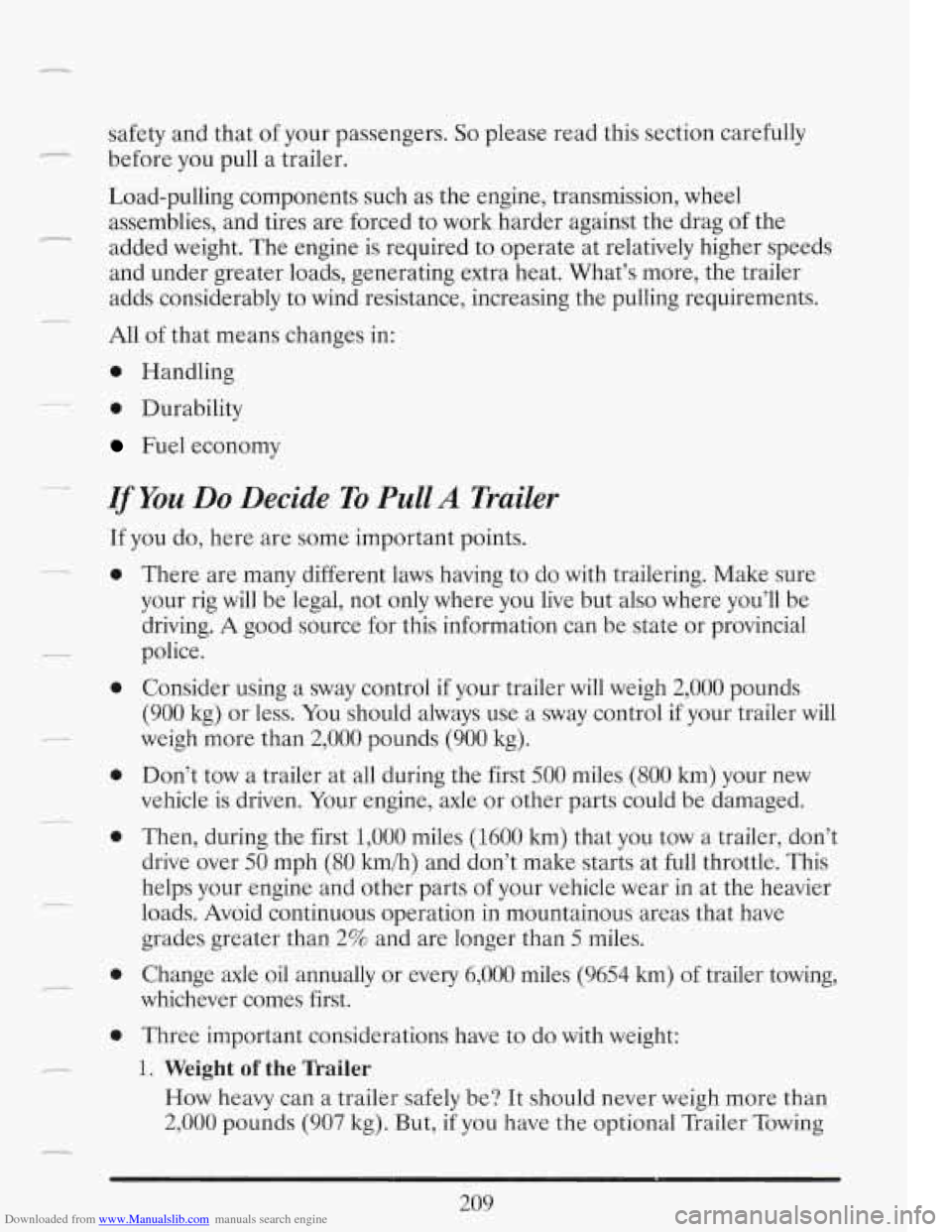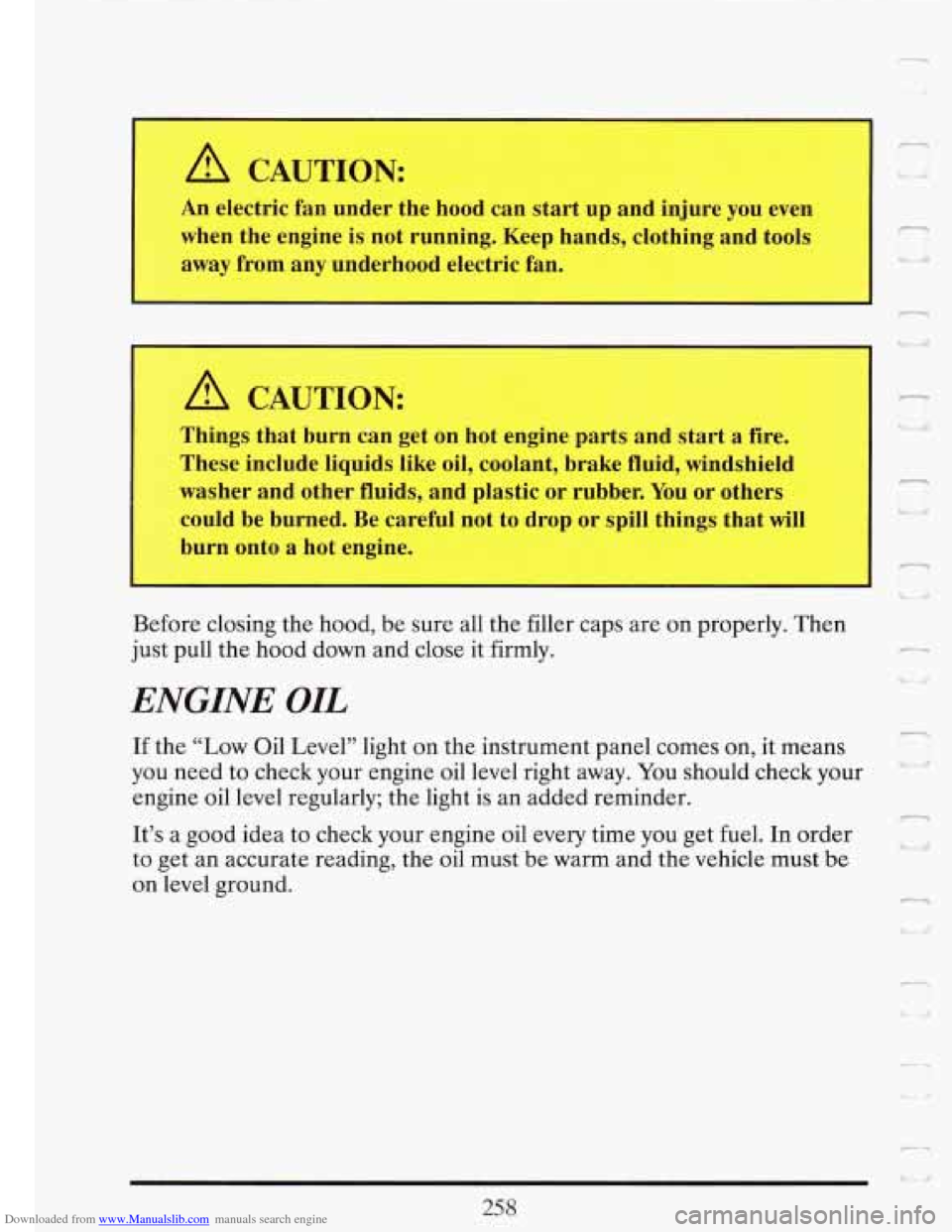Page 210 of 386

Downloaded from www.Manualslib.com manuals search engine time and flash your brake lights (in addition to your turn signal) as extra
warning that you are about to slow down and exit.
The exit ramp can be curved, sometimes quite sharply.
-.
U t I! The exit speed is usually posted. Reduce your speed according to your
speedometer, not to your sense
of motion. After driving for any distance
at higher speeds, you may tend to think you are going slower than you
actually are. For example,
40 mph (65 h/h) might seem like only 20 mph c_?
(30 km/h). Obviously, this could lead to serious trouble on a ramp
designed for
20 mph (30 kmih)!
I
L/
DRIVTNG A LONG DISTANCE
Although most long trips today are made on freeways, there are still
many made on regular highways.
Long-distance driving on freeways and regular highways is the same in
some ways. The trip has
to be planned and the vehicle prepared, you
drive at higher-than-city speeds, and there are longer turns behind the
wheel. You’ll enjoy your trip more if you and your vehicle are in good
shape. Here are some tips for a successful long trip.
BEFORE LEAWNG ONA LONG TRlP
Make sure you’re ready. Try to be well rested. If you must start when
you’re not fresh
-- such as after a day’s work -- don’t plan to make too
many miles that first part of the journey. Wear comfortable clothing and
shoes you can easily drive in.
.3
I
F i ! u
Is your vehicle ready for a long trip? If you keep it serviced and
maintained, it’s ready to
go. If it needs service, have it done before
starting out. Of course, you’ll find experienced and able service experts in
Cadillac dealerships all across North America. They’ll be ready and
7
willing to help if you need it. -1
Here are some things you can check before a trip:
Windshield Washer Fluid: Is the reservoir full? Are all windows clean
inside and outside?
Wiper Blades: Are they in good shape?
0 Fuel, Engine Oil, Other Fluids: Have you checked all levels?
Page 223 of 386

Downloaded from www.Manualslib.com manuals search engine *_
safety and that of your passengers. So please read this section carefully
before you pull a trailer.
Load-pulling components such as the engine, transmission, wheel
assemblies, and tires are forced to work harder against the drag
of the
added weight. The engine is required to operate at relatively higher speeds
and under greater loads, generating extra heat. What’s more, the trailer
adds considerably to wind resistance, increasing the pulling requirements.
All of that means changes in:
0 Handling
0 Durability
Fuel economy
If You Do Decide To Pull A Trailer
If you do, here are some important points.
0
0
0
0
0
0
There are many different laws having to do with trailering. Make sure
your rig will be legal, not only where you live but also where you’ll be
driving.
A good source for this information can be state or provincial
police.
Consider using a sway control if your trailer will weigh
2,000 pounds
(900 kg) or less. You should always use a sway control if your trailer
will
weigh more than 2,000 pounds (900 kg).
Don’t tow a trailer at all during the first 500 miles
(800 km) your new
vehicle is driven. Your engine, axle or other parts could be damaged.
Then, during the first
1,000 miles (1600 km) that you tow a trailer, don’t
drive over
50 mph (80 km/h) and don’t make starts at full throttle. This
helps your engine and other parts of your vehicle wear in at the heavier
loads. Avoid continuous operation
in mountainous areas that have
grades greater than
2% and are longer than 5 miles.
Change axle
oil annually or every 6,000 miles (9654 km) of trailer towing,
whichever comes first.
Three important considerations have to do with weight:
1. Weight of the nailer
How heavy can a trailer safely be? It should never weigh more than
2,000 pounds (907 kg). But, if you have the optional Trailer Towing
Page 229 of 386
Downloaded from www.Manualslib.com manuals search engine - Maintenance when Trailer Towing
Your vehicle will need service more often when you’re pulling a trailer.
See the Maintenance Schedule for more on this. Things that are
(don’t overfill), engine oil, axle lubricant, belt, cooling system, and brake
adjustment. Each
of these is covered in this manual, and the Index will
__- help you find them quickly. If you’re trailering, it’s a good idea to review
these sections before you start your trip.
Check periodically to see that all hitch nuts and bolts are tight.
rc-.- especially important in trailer operation are automatic transmission fluid
215
Page 243 of 386
Downloaded from www.Manualslib.com manuals search engine .- COOLING SYSTEM
-- When you decide it’s safe to lift the hood, here’s what you’ll see:
Coolant recovery tank
-? Radiator pressure cap
Electric engine fans
(If Equipped)
A CAUTION:
An electric fan under the hood can start up even when the
engine is not running and can injure you. Keep hands, clothing
and tools away from any underhood electric fan.
~
If the coolant inside the coolant recovery tank is boiling, don’t do
anything else until it cools down. -
229
Page 245 of 386
Downloaded from www.Manualslib.com manuals search engine - How to Add Coolant to the Coohnt Recovery Tank
If you haven’t found a problem yet, but the coolant level isn’t at or above
“FULL COLD,” add a 50/50 mixture of clean water (preferably distilled)
Coolant” in the Index for more information about the proper coolant
mix.)
- and a proper antifreeze at the coolant recovery tank. (See “Engine
,-
A CAUTION:
I Adding only plain water to your cooling system can be
dangerous. Plain water, or some other liquid like alcohol, can
boil before the proper coolant mix
will. Your vehicle’s coolant
water or the wrong mix, your engine could get too hot but you
wouldn’t get the overheat warning. Your engine could catch fire
water and
a pmqer antifreeze.
I warning system is set for the proper coolant mix. With plain
I and you or others could be burned. Use a 50/50 mix of clean
23 1
Page 257 of 386
Downloaded from www.Manualslib.com manuals search engine L
Remove any rust or dirt from the wheel bolts, mounting surfaces or spart?
ci .. .&', - 1::
wheel.
k r __
Place the spare on the
wheel mounting
surface.
I
A CAUTION:
Never use oil or grease on studs or nuts. If you do, the nuts
might come loose. Your wheel could fall
off, causing a serious
accident.
Page 268 of 386

Downloaded from www.Manualslib.com manuals search engine You should ask your service station operators if their gasolines contain
detergents and oxygenates, and if they have been reformulated to reduce
vehicle emissions.
FUELS IN FOREIGN COUNTMES
If you plan on driving in another country outside the U.S. or Canada,
unleaded fuel may be hard to find.
Do not use leaded gasoline. If you use
even one tankful, your emission controls won’t work well or at all. With
continuous use, spark plugs can get fouled, the exhaust system can
corrode, and your engine
oil can deteriorate quickly. Your vehicle’s
oxygen sensor
will be damaged. All of that means costly repairs that
wouldn’t be covered by your warranty.
To check on fuel availability, ask an auto club, or contact a major oil
company that does business in the country where you’ll be driving.
You can also write us at the following address for advice. Just tell
us
where you’re going and give your Vehicle Identification Number (VIN).
General Motors of Canada Ltd.
International Export Sales
PO. Box 828
Oshawa, Ontario L1H 7N1, Canada
n
Li
c
L4 , ,t
‘i nl
254
Page 272 of 386

Downloaded from www.Manualslib.com manuals search engine A CAUTION:
An electric fan under the hood can start up and injure you even
when the engine is not running. Keep hands, clothing and tools
away from any underhood electric fan.
A CAUTION:
Things that burn can get on hot engine parts and start a fire.
These include liquids like oil, coolant, brake fluid, windshield
washer and other fluids, and plastic or rubber.
You or others
could be burned. Be careful not to drop or spill things that will
burn onto
a hot engine.
I
Before closing the hood, be sure all the filler caps are on properly. Then
just pull the hood down and close it firmly.
ENGINE OIL
If the “Low Oil Level” light on the instrument panel comes on, it means
you need to check your engine oil level right away. You should check your
engine oil
level regularly; the light is an added reminder.
It’s a good idea to check your engine oil every time you get
fuel. In order
to get an accurate reading, the oil must be warm and the vehicle must be
on level ground. c1
u